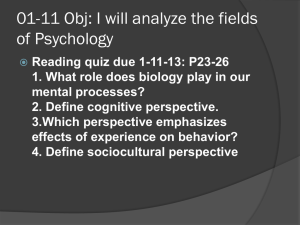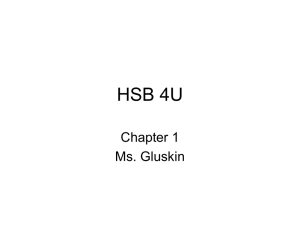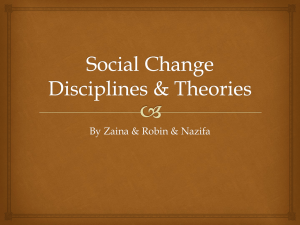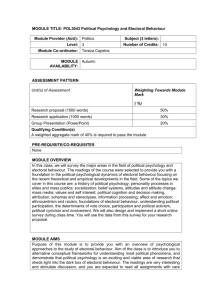The Poker Paradox final
advertisement
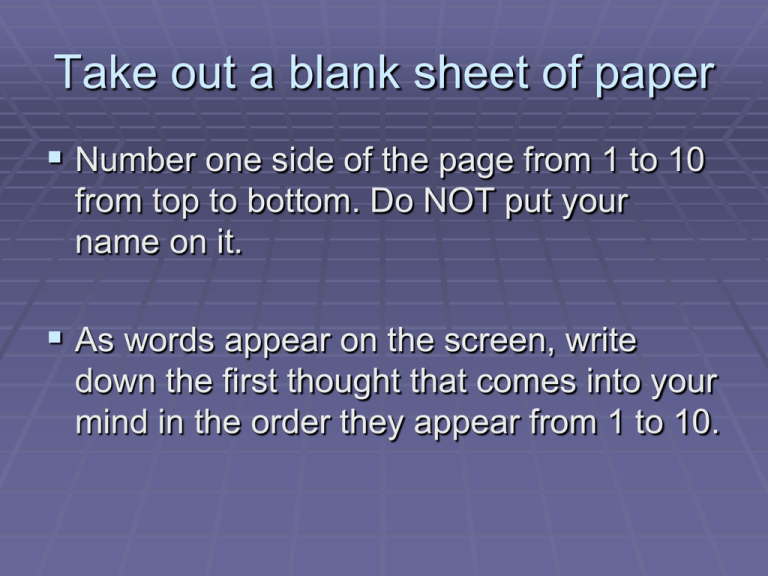
Take out a blank sheet of paper Number one side of the page from 1 to 10 from top to bottom. Do NOT put your name on it. As words appear on the screen, write down the first thought that comes into your mind in the order they appear from 1 to 10. Time Death Love Mother Red Water Home Friend Fear Balloon Fold the page in half and put it in the box as I come around. As you read the person’s responses, what are some assumptions you can make about them, write these assumptions on the right side of the page and explain them. Psychology – the scientific study of behaviour and mental processes. Comes from the Greek – “psyche” – soul and “logos” – to know It means literally “to know the soul” The goals of psychology: To describe behaviour by gathering information Explain why people behave as they do Predict what humans will think, feel, or do based on acquired knowledge Influence behaviour in a helpful manner. History is an important part of psychology because all aspects of psychological functioning involve some form of history: Physiology – genes give you billions of years of stored history of successful mutation Perception – perception is never instantaneous Memory – recall of the past Cognition – thinking, judging, decisions about the future Learning – past learning guides present behaviour Social/Cultural – knowledge passed down through institutions, cultures, families. Therefore the history of perceptions creates ambiguity or uncertainty that leads to unpredictable and often harmful effects. By studying the processes of these types of history, we gain knowledge of our perceptions and a better, more clear picture of reality. With this we can make better decisions. The basis of knowing is how we learn about the world The problem is that the world is NOT self- explanatory – the reason for the being and becoming of things, events, and people are not made known to us be simple observation of our universe nor by thinking about them. Basically, the causes of events/objects/changes are not easy to discover The Poker Paradox How can one person be good at poker and another, who understands the rules as well, be bad? Because the good player understands psychology. Imagine this table… Raymer Helmuth Ferguson Dealer Lederer You What are some things you can OBSERVE to help you reach your decision? Actions of your opponents (“tells”): •Breathing •Twitching •Tapping •Coughing •Sweating •Showing emotion What are some things that you CAN’T observe that help you make your decision? •The situation of the game – bet/call/raise/check •Your own hand! •The history of the hand, the history of each player, the history of your last few games •What cards are still out there, what odds do you have for an out. Psychology is based on the same set of problems and assumptions as poker. From the observable information, we attempt to discern the unobservable. 2 main outputs for “players” to study: Behaviour – overt and public, can be observed and measured with high accuracy Cognition/Emotion – internal events that can only be self-reported (introspection). Can be unreliable. Psychology uses scientific method to achieve accuracy. Identify a problem Develop a hypothesis (and a null) Gather data Analyze results Conclusion Varieties of inquiries There are various types of inquiries, each appropriate for a different type of hypothesis or problem. Case Studies Experiments Sample Surveys Interviews Observation All good scientific research has… Reliability – the extent to which an experiment yields the same result on repeated trials. Validity – the extent to which an experiment is accurately targeted to test the hypothesis stated. The doctor gathered the notes from her observations and added them to the test results she had obtained The patient walked into the doctor’s office and complained of fever and lack of energy. The doctor concluded that the patient had the flu. The doctor thought that the patient might have the flu that was going around. The doctor prescribed rest, aspirin, and plenty of liquids. The doctor inspected the patient’s eyes, nose, and throat and ordered some tests. 2 types of observation Naturalistic observation – the observer is seen by the subjects and is located in the environment. Controlled observation – the observer is unseen by the participants and the experiment takes place in a lab. Case study Observation of an individual or group over a long period of time. Hypothesis the purpose of an experiment. A single statement that the rest of the experiment seeks to prove or disprove. Dependant Variable The factor of the experiment that will be affected by a change in the independent variable. Independent Variable the factor to be manipulated in an experiment Control Group a group of subjects that is monitored for comparison. The independent variable is not altered for this group. Usually the observer will not know which group is which – Double blind experiment Random sample selection of subjects at random from a population. The guarantee of randomness increases the generalizability of the findings Sample size (why is it important ?) greater the sample size, the more reliable the result Unstructured Observation studying a group with no predetermined idea of what to look for. Structured Observation studying a group with a specific target behaviour to be recorded. Participant Observation the observer is seen by the subjects and is located in the environment. Experimental design The demands of each set of variables, the nature of the hypothesis being tested, and the constraints of ethics and logistics will all determine which is the best type of experiment method to follow
